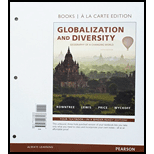
The description regarding the different kinds of tectonic plate boundaries with sketch and the differences that cause them.
Answer to Problem 2.1R
There are three types of tectonic plate boundaries. Convergent plate boundaries involve in the collision of two lithospheric plates to form subduction zone where denser oceanic plate slides beneath the continental plates or continental collision where the plates do not subduct rather collide and uplift into great orogenic belts or towering mountains. Example for subduction zones are Mariana trench, offshore of eastern japan and the best example for continental collision is Himalayas. Divergent plate boundaries exist where two or more plates are moving apart from each other. Transform plate boundaries exist where two plates are “sliding’” past one-another. The sketches of three types of plate boundaries are given as follows:

Explanation of Solution
The theory of plate tectonic states that the Earth’s outer layer lithosphere consists of large plates that move slowly across its surface, where the driving motion of these plates is the exchange of heat from deep within the Earth. Oceans and continents rest on these plates. These plates contain different margins and boundaries and are characterized by earthquakes, volcanoes and related hazards. There are three types of plate boundaries based on their movements, namely convergent, divergent and transform plate boundaries.
Convergent plate boundary- Convergent plate boundaries (destructive boundaries) are formed when two or more lithospheric plates move toward each other and collide. It has two different setting; one is ocean-continent collision and continent-continent collision.
“Convergent plate boundaries involves in the collision of oceanic and continental plates where denser oceanic plate slides beneath the continental plates to form subduction zone.” Deep trenches characterize subduction zones where the sinking ocean plate is pulled downward. Examples of subduction zones are offshore of eastern Japan, off the northwest coast of North America, off west coast of South America, and near the Philippines, where the Mariana Trench is the deepest point of the world’s oceans at 35,000 feet (10,700 meters) below the surface. Subduction zones are also characterized of powerful earthquakes, tsunamis and volcanoes. Convergent plate boundary involves two continental plate collision, in which the plates do not subduct rather collide and uplift into great orogenic belts or towering mountains. For example, Himalayas.
Divergent plate boundary - Divergent plate boundaries (Constructive plate boundaries) are formed when two lithospheric plates move away from each other. In case, when the two oceanic lithospheres are diverging apart, magma from the interior of the Earth flows to the surface resulting in active volcanoes, and mountain ranges. For example, Iceland lies on the divergent plate boundary in the North Atlantic that bisects the Atlantic Ocean. However, other divergent boundaries which involve two continental plates form deep depressions are called rift valleys and ocean ridges. For example, it is the area occupied by the Red Sea between northern Africa and Saudi Arabia.
Transform plate boundary – A plate boundary is formed when two lithospheric plates move laterally past each other. For example, the San Andreas is a transform fault, with the eastern side of the Pacific Plate moving laterally northward past the North American Plate pushing it sideways at a rate of several inches each year. Transform boundaries are characterized by destructive earthquakes.
Want to see more full solutions like this?
Chapter 2 Solutions
Globalization and Diversity: Geography of a Changing World, Books a la Carte Edition; Modified Mastering Geography with Pearson eText -- ValuePack (5th Edition)
 Applications and Investigations in Earth Science ...Earth ScienceISBN:9780134746241Author:Edward J. Tarbuck, Frederick K. Lutgens, Dennis G. TasaPublisher:PEARSON
Applications and Investigations in Earth Science ...Earth ScienceISBN:9780134746241Author:Edward J. Tarbuck, Frederick K. Lutgens, Dennis G. TasaPublisher:PEARSON Exercises for Weather & Climate (9th Edition)Earth ScienceISBN:9780134041360Author:Greg CarbonePublisher:PEARSON
Exercises for Weather & Climate (9th Edition)Earth ScienceISBN:9780134041360Author:Greg CarbonePublisher:PEARSON Environmental ScienceEarth ScienceISBN:9781260153125Author:William P Cunningham Prof., Mary Ann Cunningham ProfessorPublisher:McGraw-Hill Education
Environmental ScienceEarth ScienceISBN:9781260153125Author:William P Cunningham Prof., Mary Ann Cunningham ProfessorPublisher:McGraw-Hill Education Earth Science (15th Edition)Earth ScienceISBN:9780134543536Author:Edward J. Tarbuck, Frederick K. Lutgens, Dennis G. TasaPublisher:PEARSON
Earth Science (15th Edition)Earth ScienceISBN:9780134543536Author:Edward J. Tarbuck, Frederick K. Lutgens, Dennis G. TasaPublisher:PEARSON Environmental Science (MindTap Course List)Earth ScienceISBN:9781337569613Author:G. Tyler Miller, Scott SpoolmanPublisher:Cengage Learning
Environmental Science (MindTap Course List)Earth ScienceISBN:9781337569613Author:G. Tyler Miller, Scott SpoolmanPublisher:Cengage Learning Physical GeologyEarth ScienceISBN:9781259916823Author:Plummer, Charles C., CARLSON, Diane H., Hammersley, LisaPublisher:Mcgraw-hill Education,
Physical GeologyEarth ScienceISBN:9781259916823Author:Plummer, Charles C., CARLSON, Diane H., Hammersley, LisaPublisher:Mcgraw-hill Education,





